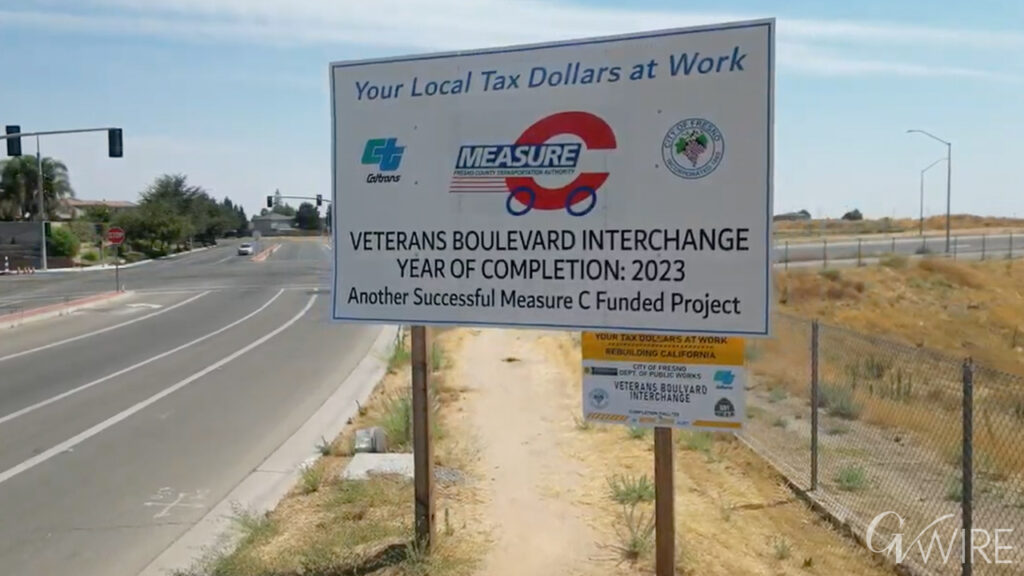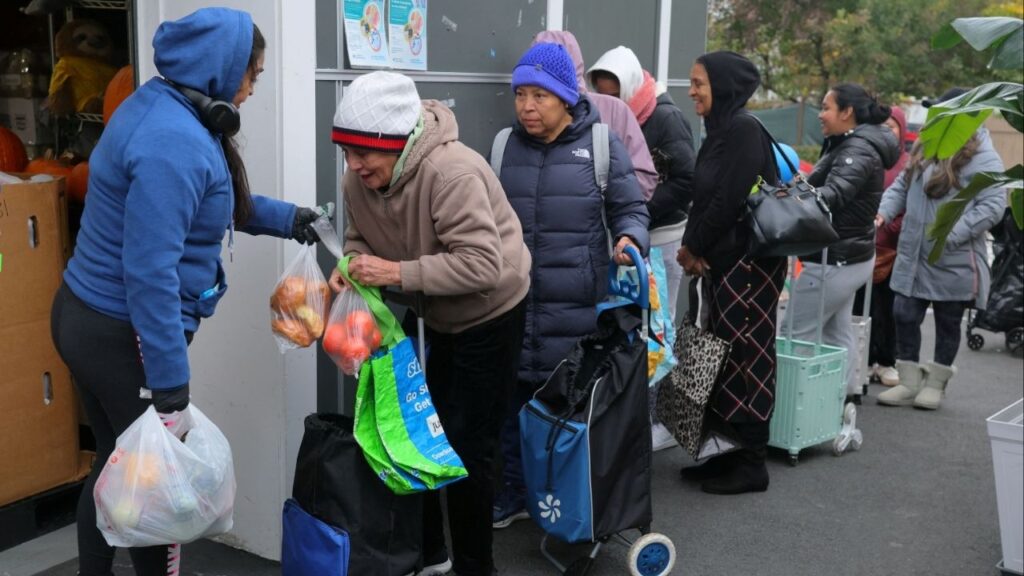Share
Advocates are sounding the alarm for what they think could be the collapse of the San Joaquin Valley’s agriculture workforce. As drought continues to hammer the state and groundwater pumping restrictions take effect, farmland will need to be retired en masse.
While there have been many conversations, including legislation, on how to support farmers during intermittent droughts, advocates say there has been little to no planning for what will happen to the nearly 167,000 farmworkers in the San Joaquin Valley when swaths of farmland are permanently fallowed. Estimates of how many farmworkers are in the Valley aren’t exact and the number is likely much higher during peak harvest season.
“We just don’t think you can plan to transition land without also planning to transition the workers that will be impacted when the land gets fallowed,” said Nataly Escobedo Garcia, water policy coordinator at nonprofit Leadership Counsel for Justice and Accountability. “We need to get on it now. We can’t keep leaving farmworkers out of these conversations.”
Up to one million acres of farmland in the valley may have to be taken out of production, according to estimates.
That’s largely because of California’s Sustainable Groundwater Management Act, a 2014 law that aims to bring overpumped aquifers back into balance, meaning generally that more water isn’t pumped out than goes back in.
Farmers have pumped groundwater for crops in the valley for decades with no limits. In drought years, they rely more heavily on pumping water due to a lack of surface water. That reliance has caused domestic and community wells to go dry and the land to sink, which has damaged critical infrastructure including roads, bridges, and canals.
Most experts agree that groundwater pumping needs to be restrained, which will affect how much food can be produced here.
But such a drastic change in the valley’s economy has not been properly planned for, according to advocates.
Coal Country Collapse Is Frightening Example
“They’re gonna leave. They have to leave because they’ve got to survive,” said Manuel Cunha, Jr., president of the Nisei Farmers League, on what farmworkers will do when land retirement begins. “The farm community dries up.”
Cunha said one of the biggest unsolved challenges for farmworkers is documentation status. Without immigration reform, farmworkers have been largely unable to get permanent residency, said Cunha. When land transitions start ramping up in the valley, that lack of residency is going to drive people away, he added.
“These are people feeding the world. These are people that may have an issue with documentation and we don’t care,” said Cunha. “Now we’re going to kick them out of their house because we can’t take care of their needs.”
It’s a mass migration scenario that has happened before in the U.S.
“We saw this with the transition away from coal, what happened in coal country. This isn’t unheard of,” said Leadership Counsel’s Garcia. “A lot of these smaller towns essentially collapsed economically. People had to leave and you saw unemployment rates skyrocket.”
Farmworkers Need Education, Transitional Support

“They’re gonna leave. They have to leave because they’ve got to survive. The farm community dries up.” — Manuel Cunha, Jr., president of the Nisei Farmers League
But that scenario could be avoided with proper support and planning, said Garcia. At a minimum, there could be some level of compensation for loss of employment for farmworkers, she said. A better plan would be to provide education and transitional support to other forms of employment, said Garcia. Multilingual education programs must be accessible and basic needs of workers should be met during those programs, she added.
Garcia said counties and local agencies should already be thinking about how this could look and whether they are going to set up adult programs to transition farmworkers into other jobs.
“We just can’t continue farming the way we have. The economy’s going to have to shift somehow,” said Garcia.
Even if groundwater pumping were to continue at current levels, farmworkers still need aid, said Garcia. Especially in times of drought when pumping increases, the aquifer shrinks and shallower drinking wells go dry. It’s a crisis some have already experienced in small towns that lost water because of proximity to fields and ag wells.
Pandemic Interrupts Planning for Aftershocks
There is some planning at the state level, according to Karen Ross, secretary of the California Department of Food and Agriculture. Although the pandemic interrupted progress on ag discussions specifically, she said.
Before the pandemic, Gov. Newsom’s office was meeting with the state Office of Planning and Research and the Labor and Workforce Development Agency to discuss job transitioning plans. But the pandemic struck just before the agencies got to agriculture, said Ross.
Ross and her department have started conversations on job transitions within ag, although it has mostly been centered around drought and not land fallowing specifically. Still, Ross says she and others are looking to the Governor’s May budget revision to see if there is any capacity for this type of support.
“We’re just beginning this work but it’s very much an active point of discussion as we work with the Governor’s Office and Department of Finance on May revise and what kind of support and relief might be available for the May revise in addition to communicating these needs to the federal government,” said Ross.
Workers Could Move Into Solar, Food Processing, Truck Driving
When it comes to options for job transitions, Ross said there are a few sectors that need more workers. Renewable energy, such as solar farms, is one area that is growing and could take farmworkers, though admittedly not as many as ag, said Ross. Farmworkers could also move to manufacturing, food processing, and truck driving, she said. But those transitions will need support and planning, admitted Ross.
Farm companies could put their workers through more apprenticeship programs to learn other skills such as management, said Ross. And many people are interested in a program similar to the federal Paycheck Protection Program to help retain and support farmworkers, she added.
State Senator Melissa Hurtado’s (D-Sanger) bill that would have established some sort of supplemental payment for farmworkers during droughts was put in the “suspense file” by the Senate Appropriations Committee Monday.
Senate Bill 1066 would allocate $20 million to provide eligible farmworker households a monthly payment of $1,000 for three years starting in 2023. Legislators will often put bills with significant costs in suspense until after the May revise of the state budget.
What Do Farmworkers Think?
The path forward needs farmworkers’ input, Ross said. Everything depends on what farmworkers want, what they’re most interested in and what gaps there are in workforce skills.

“We can future-proof ourselves. … So shame on us if we don’t really sit in this drought working together to create the jobs of the future and know the pathway that we’re going.” — Karen Ross, secretary of the California Department of Food and Agriculture
“We need to have a plan,” said Hernan Hernandez, executive director of California Farmworker Foundation, a nonprofit that supports farmworkers. “That plan needs to incorporate farmworkers.”
The California Farmworker Foundation started workforce development four years ago to get ahead of SGMA and the coming changes. Hernandez and his staff didn’t wait for instructions or guidance from the state or any other agency.
While the manufacturing industry has largely disappeared from the Bay Area and LA, it’s still alive in the San Joaquin Valley, said Hernandez. That industry could be where many farmworkers pivot. But there needs to be more education and training, said Hernandez.
Community colleges offer many programs that could serve this purpose but getting farmworkers to enroll and attend is another challenge, he added.
A mass migration event does concern the state, said the Department of Food and Agriculture’s Ross. But drought response can also be used for job transitioning and support within land fallowing, she said.
“We can future-proof ourselves,” said Ross. “Learning from this drought and understanding which programs are most effective will better prepare us for the ultimate evolution of SGMA and coming back into balance over 20 years. So shame on us if we don’t really sit in this drought working together to create the jobs of the future and know the pathway that we’re going.”
About SJV Water
SJV Water is an independent, nonprofit news site dedicated to covering water in the San Joaquin Valley.



















